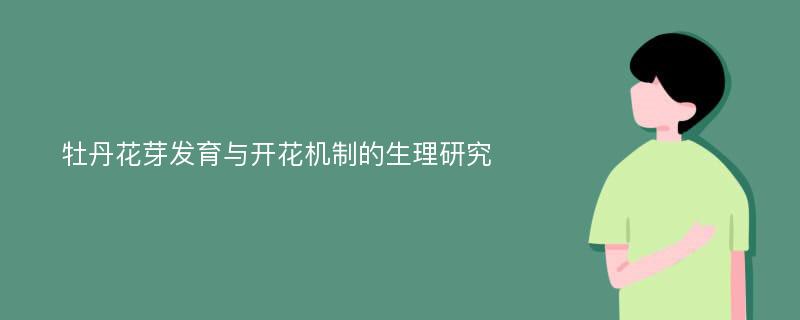
论文摘要
牡丹(芍药属牡丹组),雍容华贵、色彩绚烂,不仅是最流行的观赏花卉,还具有十分重要的经济、文化和药用价值。开花的生理学机制与商品花卉的生产密切相关,十分重要,能否开花是花卉繁殖的第一步,进而影响花卉品质和产量。牡丹的花芽形成时期和顶芽的激素水平决定了开花时间和品质,并影响花卉的观赏性。众多研究者希望通过栽培条件(露地或保护地)的改变来改善牡丹花期单一和开花期较短的难题。因缺乏对牡丹花芽发育及开花生理机制的深入研究,许多的栽培实践总是受到挫折。本研究在露地和促成栽培条件下,对多个牡丹品种的正常和败育花芽的不同发育时期(包括休眠期)的激素和糖类化合物的含量变化进行了分析研究,主要结果如下:1.牡丹顶芽的多个内源激素(吲哚乙酸IAA、脱落酸ABA和赤霉素GA3)水平和糖类化合物(蔗糖、还原糖及淀粉)的含量变化与牡丹的秋季二次开花密切相关,能够秋季开花的花芽通过增加吲哚乙酸、赤霉素GA3、蔗糖及还原糖的积累,减少脱落酸和淀粉的含量诱导开花。通过对吲哚乙酸在秋季开花和春季开花的花芽发育过程中含量的比较,发现秋季二次开花的花芽在花芽膨大期、茎伸长期和初开期这三个花芽发育的重要时期均出现了吲哚乙酸高峰值(含量),这表明其对秋季二次开花的花芽诱导及促成开花十分重要。因此,低脱落酸、蔗糖和还原糖含量与高淀粉含量打破了牡丹“傲霜”品种在秋季花芽形成初期的休眠,进而促成了其在秋季二次开花。2.秋花品种(“傲霜”和“藏枝红”)和非秋花品种(“洛阳红”)在花芽形成过程中(花芽诱导期、萌动期和分化期)的内源激素(赤霉素GA3和GA4、吲哚乙酸IAA及细胞分裂素)含量的变化影响了这两类品种的开花模式。细胞分裂素CTK(ZR和iPA)在这两类品种的整个花芽发育过程中存在显著性差异,是秋季开花的关键激素。赤霉素GA3和GA4及吲哚乙酸IAA仅在花芽的诱导期和萌动期存在显著性差异,但在整个花芽发育过程中赤霉素GA3在秋花品种中的含量始终高于春花品种,呈负水平的显著性差异。脱落酸和糖类化合物(蔗糖、还原糖和淀粉)对牡丹品种的开花模式影响较小。所以,牡丹的秋季开花主要是通过调节花芽发育关键时期(花芽诱导期和萌动期)的赤霉素GA3、吲哚乙酸IAA和细胞分裂素CTK的含量,进而促成秋花花芽在休眠前形成来实现的。3.牡丹花芽在冬季低温条件下因富集了脱落酸ABA、淀粉、蔗糖及还原糖而诱导了休眠,而春季随着气温度升高,花芽中的脱落酸ABA、淀粉、蔗糖及还原糖被降解的同时却又富集了赤霉素GA3进而打破了休眠,这表明环境温度通过调节花芽中激素和糖类化合物含量,进而影响花芽休眠与生长。此研究表明,花芽中脱落酸ABA、赤霉素GA3和糖类物质的积累与花芽在休眠期或发芽期的温度变化直接相关,脱落酸ABA和细胞分裂素在低温条件下积累,但赤霉素GA3的含量随着温度的升高而增加。另外,花芽中脱落酸ABA和细胞分裂素含量减少在打破花芽休眠或促进花芽生长方面有重要作用。4.各测试牡丹品种花芽内蔗糖和淀粉含量随季节性变化的模式几乎一样,这与前人研究的花芽中蔗糖和淀粉含量会在冬季出现积累的现象并不一致。花芽内源成分的季节性积累在不同品种问也是不一样的,与“赵粉”和“正午”相比,“洛阳红”仅积累少量的脱落酸ABA、赤霉素GA3、淀粉、蔗糖和R-糖,并很早就能解除花芽的休眠。5.对“洛阳红”植株进行冷藏和赤霉素GA3(200 mg/L)共处理,因为根尖和顶芽在冷处理诱导下减少了脱落酸ABA的含量并增加了糖类物质,促进了芽的发育及开花过程,减少了花芽败育。在赤霉素GA3(200 mg/L)处理时,植株直接冷藏处理后的开花率是58%,而盆栽冷藏处理后的开花率仅为21%。总之,冷藏结合赤霉素处理可以促进植株的生长和发育,特别是花芽的萌发、生长及开花。
论文目录
摘要ABSTRACTTABLE OF CONTENTS1. INTRODUCTION1.1. Background1.2. Statement of the Problem1.3. Significance of the Study1.4. Objective of the Study1.5. Thesis Statement(Hypothesis)2. LITERATURE REVIEW2.1. Origin,Botany and Distribution of Tree Peony2.1.1. Cultivar Development of Tree Peony2.1.2. Ecological Conditions of Tree Peony2.1.3. Morphological Characteristics of Peony2.1.4. Importance of Tree Peony2.2. Autumn-flowering in Tree Peony2.3. Bud Dormancy in Woody Plants2.3.1. Factors Influencing Bud Dormancy2.3.2. Photoperiod2.3.3. Temperature2.3.4. Plant Hormones2.4. Bud Dormancy Induction2.4.1. Bud Dormancy Release2.4.2. Physiological Processes Associated with Dormancy Induction and Release2.5. Flower Bud Development in Woody Plants2.5.1. Flower Bud Induction2.5.2. Flower Bud Initiation2.5.3. Flower Bud Differentiation2.5.4. 2.6 Bud Abortion3. Dynamic Changes of Endogenous Hormones and Sugars in Autumn flowering Tree Peony 'AoShuang'3.1. Introduction3.2. Material and methods3.2.1. Sample Collection3.2.2. Hormone Extraction,Purification and Analysis3.2.3. Soluble Sugar Extraction and Analysis3.2.4. Statistical Analysis3.3. Results and Analysis3.3.1. Bud Hormonal Content3.3.2. Bud Hormonal Interaction3.3.3. Bud Carbohydrate Content3.4. Discussion3.4.1. Effect of Hormones on Bud Growth,Development and Flowering3.4.2. Endogenous Hormones Interaction3.4.3. Effect of Nutrients on Bud Growth, Development and Flowering3.4.4. Dormancy and Flower Bud Growth in Tree Peony4. The Levels of Hormone and Carbohydrate in Autumn and Non-autumn Flowering Tree Peonies4.1. Introduction4.2. Materials and Methods4.2.1. Plant Materials4.2.2. Plant Treatments and Sampling4.2.3. Flower Bud Morphology Observation4.2.4. Hormone Extraction and Analysis4.2.5. Soluble Sugar Extraction and Analysis4.2.6. Statistical Analysis4.3. Results and Analysis4.3.1. Tree Peony Bud Morphological Change4.3.2. Bud Differentiation Process in Tree Peony4.3.3. Comparison of Autumn and Non-Autumn Tree Peony Flowering Cycle4.3.4. Hormone Content of Apical Buds4.3.5. Carbohydrate Content of Apical Buds4.4. Discussion4.4.1. Autumn Flowering and Non-Autumn Flowering Cycle4.4.2. Hormone Effect on Flower Bud Formation4.4.3. Carbohydrate Effect on Flower Bud Formation5. Gibberellin and Cytokinin Levels Associated with the Autumn Flowering Tree Peony5.1. Introduction5.2. Materials and Methods5.2.1. Plant Materials and Sample Collection5.2.2. Observation of Bud Morphology5.2.3. Hormone Extraction, Purification and Quantification5.2.4. Statistical Analysis5.3. Results and Analysis5.3.1. Morphology of Tree Peony Bud5.3.2. Comparison of Autumn and Non-autumn Flowering Tree Peony Cycle5.3.3. hormonal content of Bud5.4. Discussion5.4.1. Hormonal Effects on Flower Bud Development6. Seasonal Changes in Endogenous Hormone and Sugars Levels During Bud Dormancy in TreePeony6.1. Introduction6.2. Materials and Methods6.2.1. Plant Materials and Sample Collection6.2.2. Changes of Bud Dormancy Intensity6.2.3. Observation of Bud Morphology6.2.4. Hormone Extraction, Purification and Quantification6.2.5. Soluble Sugar Extraction and Analysis6.2.6. Statistical Analysis6.3. Results and Analysis6.3.1. Bud Dormancy, Temperature and Morphological Changes6.3.2. Changes of Bud Dormancy Intensity6.3.3. Change of Hormone Levels in Buds6.3.4. Change of Carbohydrate Levels in Buds6.4. Discussion6.4.1. Hormone, Temperature and Dormancy6.4.2. Carbohydrate, Temperature and Dormancy3) Application on Bud Abortion offorced tree peony'>7. The Effect of Chilling Method Combined with Gibberellin (GA3) Application on Bud Abortion offorced tree peony7.1. Introduction7.2. Materials and Methods7.2.1. Plant Materials and Sampling7.2.2. Hormone and Sugar Extraction and Analysis7.3. Result and Analysis7.3.1. Effect of Chilling Method in Combination with GA3 Application on the Development of'Luoyang Hong'3 Applications on Hormonal Content of Buds'>7.3.2. Effect of Chilling Methods in Combination of GA3 Applications on Hormonal Content of Buds7.3.3. Hormonal Content in Retained and Aborted Buds7.3.4. Sugar Content in Retained and Aborted buds7.4. Discussion3 Application'>7.4.1. Development of 'Luoyang Hong' Tree Peony and the Effects of Chilling Method in Combinationwith GA3Application3Application'>7.4.2. Hormonal Contents of Buds and the Effects of Chilling Method in Combination with GA3Application3 Applications on Hormone and Sugar Contents inRetained and Aborted Flower Buds'>7.4.3. Effect of Chilling Method Combined with GA3 Applications on Hormone and Sugar Contents inRetained and Aborted Flower Buds8. General Conclusions and Recommendations8.1 Conclusions8.2 Recommendations参考文献个人简介导师简介获得成果目录致谢附件
相关论文文献
- [1].大花蕙兰花芽发育期开花株与不开花株可溶性糖含量比较[J]. 山东林业科技 2010(03)
- [2].营养元素对马缨杜鹃花芽发育和花期的影响[J]. 北方园艺 2010(21)
- [3].基于影像资料的鸭梨开花物候期与气象影响因子关系初探[J]. 沙漠与绿洲气象 2019(05)
- [4].冬季土壤自然封冻始期4个品种芍药的花芽发育状态[J]. 西北林学院学报 2016(03)
- [5].东京野茉莉花芽发育过程中的生理特性[J]. 江苏农业科学 2018(05)
- [6].露地和日光温室甜樱桃花芽发育特征及胚珠多糖定位观察[J]. 果树学报 2012(03)
- [7].毛白杨PtLFY在花芽发育中的表达模式与花芽形态分化[J]. 林业科学 2010(02)
- [8].不同梅树品种的花芽发育过程及花芽中成花基因和看家基因的表达特性[J]. 植物资源与环境学报 2019(02)
- [9].不良气候条件对猕猴桃花芽发育的影响[J]. 北方果树 2014(06)
- [10].积温对比法在鸭梨始花期预报中的应用[J]. 气象科技 2019(05)
- [11].影响南京甜樱桃坐果的关键时期[J]. 园艺学报 2015(06)
- [12].不良气候条件对猕猴桃花芽发育的影响[J]. 农民致富之友 2014(16)
- [13].不同类型雄性不育苎麻细胞学机理研究[J]. 湖南农业大学学报(自然科学版) 2014(01)
- [14].光周期和温度对胭脂花生长发育的影响[J]. 北京林业大学学报 2013(05)
- [15].棚室樱桃的花果管理[J]. 北京农业 2008(04)
标签:牡丹芍药属牡丹组论文; 糖类论文; 植物激素论文; 花芽形成论文; 休眠论文;

